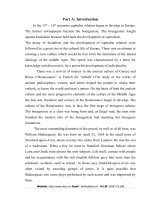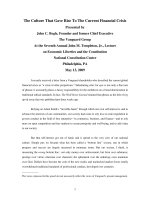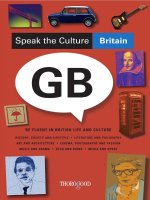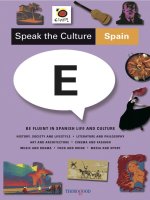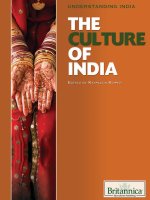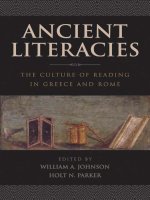speak the culture spain
Bạn đang xem bản rút gọn của tài liệu. Xem và tải ngay bản đầy đủ của tài liệu tại đây (23.57 MB, 356 trang )
Speak the Culture Spain
www.thorogoodpublishing.co.uk www.speaktheculture.co.uk
E
BE FLUENT IN SPANISH LIFE AND CULTURE
HISTORY, SOCIETY AND LIFESTYLE
•
LITERATURE AND PHILOSOPHY
ART AND ARCHITECTURE
•
CINEMA AND FASHION
MUSIC AND DRAMA
•
FOOD AND DRINK
•
MEDIA AND SPORT
Speak the Culture Spain
All rights reserved.
No part of this publication may
be reproduced, stored in a
retrieval system or transmitted
in any form or by any means,
electronic, photocopying,
recording or otherwise, without
the prior permission of the
publisher.
This book is sold subject to the
condition that it shall not, by
way of trade or otherwise, be
lent, resold, hired out or
otherwise circulated without
the publisher’s prior consent in
any form of binding or cover
other than in which it is
published and without a similar
condition including this
condition being imposed upon
the subsequent purchaser.
No responsibility for loss
occasioned to any person acting
or refraining from action as a
result of any material in this
publication can be accepted by
the author or publisher.
All has been done to trace the
owners of the various pieces of
material used for this book. If
further information and proof of
ownership should be made
available then attribution will
be given or, if requested, the
said material removed in
subsequent editions.
A CIP catalogue record for this
book is available from the
British Library.
ISBN: 1 85418605 1
978-185418605-8
Thorogood Publishing Ltd
10-12 Rivington Street
London EC2A 3DU
Telephone: 020 7749 4748
Fax: 020 7729 6110
www.thorogoodpublishing.co.uk
www.speaktheculture.co.uk
© 2008
Thorogood Publishing Ltd
Las Palmas de Gran Canaria
Special thanks to Olatz
Gonzalez, Instituto Nacional
de Estadística, Instituto de
Turismo de España, Neil
Mackay and to Marcus Titley
(www.seckfordwines.co.uk) for
his food and drink expertise.
Acknowledgements
Neil Thomas
Editorial Director
Angela Spall
Andrew Whittaker
Editorial contributors
Sam Bloomfield
Joanne Fairweather
Julie Lewthwaite
Amy Wilson Thomas
Alexandra Fedoruk
Nial Harrington
Harrington Moncrieff
www.hmdesignco.com
Johnny Bull
plumpState
www.plumpstate.com
Printed in the UK by
Henry Ling Ltd
www.henryling.co.uk
Publisher Design & illustrationEditor in chief
Speak the Culture
books give you thekeys
to a nation’s culture
1.1. Geography p5
1.1.1. The lie of
the land p6
1.1.2. Local colour: the
autonomías of Spain p10
1.2. History p37
1.2.1. Caves and
conquests: from the
Stone Age to the
Reconquista p38
1.2.2. Rise and fall:
kings, conquistadores and
cultural highs p43
1.2.3. Ruin to
resurrection: war,
dictatorship and
democracy in modern
Spain p48
1.3. Language and
psyche p55
1.3.1. Vocal harmonies:
Spain and its languages
p56
1.3.2. Being Spanish:
identity and psyche p60
2.1. Literature p65
2.1.1. Spanish reading
habits p66
2.1.2. Rising stars:
Seneca, El Cid and La
Celestina p68
2.1.3. In search of Don
Quixote: literature in the
Golden Age p72
2.1.4. In Cervantes’
shadow: from Romantics
to Realists p77
2.1.5. Generation game:
Unamuno, Lorca and Cela
p83
2.1.6. Off the leash:
contemporary Spanish
literature p91
2.2. Philosophy p97
2.2.1. Think tank:
the big names of Spanish
philosophy p98
3.1. Art p107
3.1.1. Painting the
Spanish way p108
3.1.2. Going up the
walls: Spanish art from
cavemen to cathedrals
p110
3.1.3. Spanish art in the
Renaissance p114
3.1.4. Naturally gifted:
Baroque era painters
p117
3.1.5. One-man show:
Goya guides Spain toward
modernity p123
3.1.6. Ripping up the
rulebook: Picasso, Dalí
and Miró p127
3.1.7. Pick ‘n’ mix:
Spanish art since the Civil
War p133
3.2. Architecture p139
3.2.1. Built to last:
prehistoric and classical
structures p140
3.2.2. How Goths,
Asturians and Moors
built the Middle Ages
p142
3.2.3. Reaching for the
heavens: Romanesque
and Gothic p147
3.2.4. Putting on a front:
Renaissance and Baroque
p153
3.2.5. Making waves:
Spanish architecture in
the modern era p159
3.2.6. Home truths:
domestic architecture,
living arrangements and
planning chaos p165
4.1. Music p171
4.1.1. Folk tales: the
roots of Spanish music
p172
4.1.2. Comeback king:
the story of flamenco
p176
4.1.3. Early and
classical Spanish
music p181
4.1.4. Homegrown
talent: the modern music
scene p187
4.2. Theatre p193
4.2.1. Golden greats:
the age of Spanish drama
p194
4.2.2. Lorca leads the
way: Spanish drama in
the modern age p199
4.2.3. Moving stories:
Spanish dance p206
4.2.4. Laughing matters:
comedy in modern Spain
p210
Introduction p1
4. Performing
arts p169
3. Art and
architecture
p105
2. Literature and
philosophy p63
1. Identity: the
building blocks of
Spanish culture p3
Contents
5.1. Cinema p215
5.1.1. Shooting pains:
the Spanish and their
films p216
5.1.2. Moving with the
times: early adventures
in film p218
5.1.3. Bending the rules:
film under Franco p221
5.1.4. Film uncut: modern
Spanish cinema p226
5.2. Fashion p235
5.2.1. Fashion sense:
designers, costumes and
global empires p236
6.1. Media p243
6.1.1. Life off the leash:
newspapers and
magazines p244
6.1.2. Love at first sight:
the Spanish and their TVs
p248
6.1.3. Radio active: in
love with the wireless
p251
6.1.4. Blog off: getting to
grips with new media
p253
6.2. Communications
p255
6.2.1. Making
connections: posting a
letter and making a call
p256
6.2.2. Spain on the
move: transport systems
and habits p258
7.1. Food p265
7.1.1. Life on the cutting
edge: the Spanish kitchen
p266
7.1.2. Staple diets:
meats, breads and a few
veg p270
7.1.3. Regional flavours:
the different tastes of
Spain p272
7.1.4. Food rituals:
eating habits, festivals
and buying food p281
7.2. Drink p287
7.2.1. The culture of
Spanish wine p288
7.2.2. Spanish wine on
the map: the regions
p293
7.2.3. From sangría to
horchata: Spain’s other
tipples p301
7.2.4. Drinking habits:
where and when to hit the
bottle p304
8.1. The changing face
of Spanish society:
class, race, family and
gender p310
8.2. Mass appeal: how
Spain takes its religion
p315
8.3. Big issues: politics,
the state and the
environment p318
8.4. On the money: the
economy, social security
and healthcare p324
8.5. Within the law:
crime, courts and the
police p328
8.6. Steep learning
curve: education p332
8.7. Time out: free time,
fiestas and holidays p335
8.8. Bulls, balls and
baskets: Spanish sport
p339
5. Cinema and
fashion p213
8. Living culture:
the details of
modern Spain p307
7. Food and drink
p263
6. Media and
communications
p241
Publisher’s Note
This series of books and
this book are designed to
look at the culture of a
country – to give readers
a real grasp of it and to
help them develop and
explore the culture of that
chosen country. At a time
of supposed blurring of
national identity, there is
celebration of cultural
diversity and also a quest
for ancestry, roots,
heritage and belonging.
There is currently much
to-ing and fro-ing in
travel, both for leisure
and work purposes,
between countries and
a great deal of second-
home ownership as well
as more permanent
changes in residence.
This has heightened the
interest in the cultural
context in which daily life
is lived. There are even
citizenship courses for
new residents in many
countries. Inevitably
all of this has brought
a fascination in the
cultures and lifestyles of
different countries, which
are the envy of some and
the pride of others.
Our focus is on increasing
the cultural knowledge
and appreciation of a
country – to enrich and
nourish the minds of
the readers and to give
them a real cultural
understanding.
This will enhance their
enjoyment of a country
and will certainly help
their communication
skills (even in their own
language) with the
‘locals’, making it more
fun all round.
I would like to thank
Andrew Whittaker as
Editor-in-Chief for
producing this book and
others in the series, and
making flesh what was
once only a twinkle in
my eye.
It is also a book to sit
alongside guidebooks
and language courses –
they will go together
like olives, a chunk of
Manchego and a glass
of Rioja.
Neil Thomas
1
Introduction
Learn how weather, war
and disparate cultures
forged modern day Spain.
Acquaint yourself with
the writers who turned
national soul searching
into literary gold.
Get to know world-famous
artists and architects,
their paintings and
buildings.
Discover who’s who in
Spanish music and
theatre, and learn why
flamenco is so important.
Meet the modern icons
of Spanish cinema and
the film-makers who bent
Franco’s rules.
Absorb the Spanish
reverence for food
and wine.
Decipher politics, religion,
sport and the media and
uncover the Spanish lust
for life.
Speak the Culture books
give you the keys
to a nation’s culture
Investigating the people, the way they live and their
creative heroes, the series unlocks the passions and
habits that define a country. Easily digested chunks of
information, bites of knowledge and helpful lists decipher
the complexities of a foreign culture, from composers
to chefs, poets to presidents, so that you might get to
know the country as one of its own citizens.
Speak the Culture: Spain begins with the country’s
foundations – the terrain, history and thought processes
on which the nation is built. Next we introduce you to the
creative icons that have become ingrained in the Spanish
psyche, from Velázquez to Lorca, Cervantes to
Almodóvar. Finally, we explore how the Spanish live,
revealing the passions, habits and tensions that shape
modern life. With these three strands Speak the Culture:
Spain unravels Spanish DNA.
1 Identity: the building
blocks of Spanish culture
1.1. Geography p5
1.1.1. The lie of the
land p6
1.1.2. Local colour:
the autonomías of Spain
p10
1.2. History p37
1.2.1. Caves and
conquests: from the
Stone Age to the
Reconquista p38
1.2.2. Rise and fall:
kings, conquistadores
and cultural highs p43
1.2.3. Ruin to
resurrection: war,
dictatorship and
democracy in modern
Spain p48
1.3. Language and
psyche p55
1.3.1. Vocal
harmonies: Spain and
its languages p56
1.3.2. Being Spanish:
identity and psyche p60
1
1. Identity: the
building blocks of
Spanish culture
2. Literature
and philosophy
3. Art and
architecture
4. Performing
arts
5. Cinema
and fashion
6. Media and
communications
7. Food and drink 8. Living culture:
the details of
modern spain
1.1 Geography
Viewed from afar it’s easy to mistake Spain
for a singular lump; for a nation of one
people, one climate and one culture
grouped on the peninsula. The reality is
infinitely more diverse. Spain is a rich
assortment of contrasting regions,
languages and customs, a place where
neighbouring towns can seem worlds apart.
Sizing up Spain
Remove neighbouring Portugal (not that you’d
want to) and Spain shapes up a bit like a t-shirt,
the historic regions of Galicia and Catalonia
sticking out like stubby sleeves. It hogs the
Iberian Peninsula, the south-western clump
of Europe that was once an island but drifted
north and collided with Europe, pushing up the
Pyrenees as it went. That epic mountainous
border with France and Andorra still feels like a
barrier, one that has traditionally disengaged
Spain from the rest of Europe and nurtured the
region’s distinctive cultural heritage. Elsewhere, much
of Spain is bordered by water: the long Mediterranean
coast covers its eastern flank, famous costas unravelling
from Catalonia down to Andalusia, while the Atlantic
both bites at the south-western corner and laps at the
northern coast, in the guise respectively of the Gulf of
Cadiz and the Cantabrian Sea. Borders with Portugal and
the British Overseas Territory of Gibralt ar complete the
picture.
Much more than dust
Spain crams more scenic variety into its frame than
might be expected of a land renowned as dry and dusty.
The northern coastal strip is lush, green with forest
and pasture, while at the southern end Spain harbours
Europe’s only bona fide desert in the Almería province of
Andalusia. In between, the meseta, a vast plateau
averaging over 500m in altitude, dominates the interior.
This upland blanket, characterised by endless sun-
battered plains, rolling hills and ripples of rugged
mountain, covers almost half the country. Mountain
ranges (sierras), thread across the meseta, but the
biggest peaks on the peninsula are found beyond, in
Islands in the sun
Spain reigns over two
significant island groups:
the Balearics off the
eastern coast are
actually a continuation
of mountain chains in
southern Spain, risen
up out of the sea; the
volcanic Canary Islands
are found off the north-
western coast of Africa.
Both archipelagos
remain key components
of the Spanish whole.
6
1. Identity: the
building blocks of
Spanish culture
2. Literature
and philosophy
3. Art and
architecture
4. Performing
arts
5. Cinema
and fashion
6. Media and
communications
7. Food and drink 8. Living culture:
the details of
modern spain
1.1.1 The lie of the land
the 400km stretch of the Pyrenees and, at greatest
height, in the snow-capped Sierra Nevada, part of the
Cordillera Bética range overlooking the southern Med
coast. Narrow strips of coastal lowland give Spain its
famous beaches, while the Andalusian Plain in the
south-west is the country’s only sizeable low-lying
patch.
Climatic chameleon
Spain’s diverse landscape, and interference from the
Mediterranean and the Atlantic, coughs up the most
varied climate in Europe. The meseta, Madrid included
within its realm, delivers a continental climate of
cold winters and baking summers, both pretty dry.
The Pyrenees and the northern coastal regions are
cooler and take the lion’s share of Spain’s rain from
weather systems rolling in off the Atlantic. In the
south, Andalusia can be jovially warm throughout the
winter but aggressively hot in summer. Along the
Mediterranean coast the climate is generally dry,
mild in winter and often hot and humid in summer.
Many of the sierras retain snow on their higher peaks
throughout the year.
Life’s a breeze: windy culture
In Catalonia they brace themselves against the
tramontana, a face-slapping northerly that also lends
its name to a mountain chain on Majorca. Salvador Dalí
painted the Christ of the Tramontana (1968) as part
of a collaboration with Catalan poet Carles Fages de
Climent, while Colombian author Gabriel García
Márquez penned Tramontana (1993), a short story in
which the main character is pushed to suicide by the
tormenting wind – an apparently regular occurrence in
Catalan days of yore. Not to be left out, southern Spain
7
1. Identity: the
building blocks of
Spanish culture
2. Literature
and philosophy
3. Art and
architecture
4. Performing
arts
5. Cinema
and fashion
6. Media and
communications
7. Food and drink 8. Living culture:
the details of
modern spain
If you can’t
stand the heat…
The flow of Spanish life
has long been guided by
the weather, the most
obvious example being
the daily siesta. While not
as widespread as of old,
the early afternoon nap
can still be a necessary
response to the torpor-
inducing heat of summer.
fears the periodic wrath of the leveche, a sirocco
wind that sweeps up from the Sahara and blasts the
coastline with dust and stifling heat. The solano is an
even hotter wind that blows through the Andalusian
Plain in summer, baking everything in its path.
Population situation
Spanish demographics rollercoastered through the
20
th
century. First the population doubled, then, in the
1960s and 70s, much of it migrated from rural areas
to the country’s burgeoning cities. Finally, in the last
two decades, the birth rate plummeted, leaving Spain’s
fertility rate among the lowest in the world – on
average women here have 1.3 children. More recently
the population has begun to grow again on the back
of extensive immigration.Today, it stands at just over
40 million. Almost four-fifths of the population live
in towns and cities, and even out in the provinces
people tend to live in large villages rather than isolated
houses. Madrid and its immediate surrounds, one
of the most densely peopled metropolitan areas in
Europe, are home to one in ten Spaniards. In contrast,
most of the rest of Spain lives a short distance from
the coast.
Keep it regional: carving Spain up
Modern Spain has been rather forward-thinking in its
acceptance of regional identities within the national
state. Thus, the country is divided into 17 autonomous
communities; their pattern shaped around historic
kingdoms like Aragón, Castile, León and Murcia. Just
how far the federal government is willing to let each
autonomía express its own identity seems to vary
Just deserts
A European Environment
Agency report of 2004
suggested that the
Iberian Peninsula will
suffer most among EU
regions from the onset of
climate change. Summers
are already getting drier
and hotter (2005 brought
the worst drought in 60
years) and storms more
severe, while glaciers on
the Spanish side of the
Pyrenees have shrunk by
as much as 50 per cent
in the last two decades.
Climate change may also
further accelerate the
serious desertification
caused by overgrazing
and mass tourism along
Spain’s south-eastern
coast. UN figures suggest
that over 30 per cent
of Spain is in danger of
becoming desert.
8
1. Identity: the
building blocks of
Spanish culture
2. Literature
and philosophy
3. Art and
architecture
4. Performing
arts
5. Cinema
and fashion
6. Media and
communications
7. Food and drink 8. Living culture:
the details of
modern spain
widely from region to region. Some of the regions are
divided into provinces, of which Spain has 50 in total.
Ceuta and Melilla, two tiny fenced off patches of Spain
clinging defiantly to the otherwise Moroccan coast of
Africa, carry the status of autonomous cities.
Area 504,000 sq km (190,000 sq miles) (around double the size of the UK)
Population approximately 40 million (and growing)
Population density (average) 81 people per sq km (210 per sq mile)
Life expectancy 76 for men and 83 for women
Visitors with almost 60 million visitors a year, Spain is the second most popular
tourist destination in the world.
Vital statistics
9
1. Identity: the
building blocks of
Spanish culture
2. Literature
and philosophy
3. Art and
architecture
4. Performing
arts
5. Cinema
and fashion
6. Media and
communications
7. Food and drink 8. Living culture:
the details of
modern spain
Northern Spain
The stripe of northern Spain running
from the border with Portugal to the
edge of the Pyrenees was once largely
unknown outside the country, outside
the region even. Rainy, not especially
warm and carpeted in green, few heard
its call above the louder voices of
Andalusia and the Mediterranean coast.
Today, the artfully named Green Spain
is better known, yet can still feel like a
region undiscovered, from the Celtic
shades of Galicia to the mysterious,
ancient culture of the Basque Country.
10
1. Identity: the
building blocks of
Spanish culture
2. Literature
and philosophy
3. Art and
architecture
4. Performing
arts
5. Cinema
and fashion
6. Media and
communications
7. Food and drink 8. Living culture:
the details of
modern spain
1.1.2 Local colour: the autonomías of Spain
i. Galicia
Most daydreams about Spain probably don’t look
much like Galicia. It’s among the greenest parts
of Green Spain, a verdant mix of hills, granite-grey
villages, rain and rías (drowned river valleys).
With its Celtic connections Galicia can feel more
like Ireland or Brittany than Iberia. Quiet villages
hide in an empty land of oak, pine and eucalyptus,
while cities like A Coruña and Vigo perch on the
coast. Famine and poverty once forced thousands
overseas to Latin America, and the region remains
less prosperous than the rest of Spain. Agriculture
and fishing are the main industries, although falling
fish stocks and a devastating oil tanker spill of 2002
have dented the latter.
11
1. Identity: the
building blocks of
Spanish culture
2. Literature
and philosophy
3. Art and
architecture
4. Performing
arts
5. Cinema
and fashion
6. Media and
communications
7. Food and drink 8. Living culture:
the details of
modern spain
Mussel pulling power
Spain’s marketing men
dubbed the varied Galician
shoreline the Costa do
Marisco (Seafood Coast) in
an effort to attract more
visitors. They’ve yet to claim
creative ownership of the
less enticing Costa de la
Muerte (Coast of Death),
given to a particularly rocky
western stretch of the region.
Both Generalísimo Francisco
Franco and President Fidel
Castro have Galician roots.
Castro’s father emigrated to
Cuba from the region, while
Franco was born and raised
in Ferrol, a naval town in
north-west Galicia.
The Camino:
road to redemption
The jaw-slackening cathedral
of Santiago de Compostela
marks journey’s end each
year for thousands of pilgrims
and hikers trekking along the
Camino de Santiago through
northern Spain. Legend has it
that Saint James’ remains
were buried under the church
after being shipped to Galicia
on board a stone boat from
Jerusalem.
Cultural differences
Weather-beaten and
bordered by sea on two
sides, Portugal on a
third and mountains on a
fourth, isolated Galicia
has developed a distinct
culture. Most here still
speak Galego (alongside
Castilian) and a TV
channel, TVG, broadcasts
solely in the local tongue.
The region boasts a rich
literary tradition, from
the scholarly work of the
14
th
century to the strong
19
th
century Romantic
movement driven by
poet Rosalía de Castro.
More recently, Galician
novelist Camilo José Cela
won the Nobel Prize
for Literature. The gaita
galega (pipes) still
resonate through Galician
music, while traditional
dress (dusted down for
festivals) has a distinctly
Gaelic feel. The rest of
Spain isn’t blind to the
differences; indeed Galicia
has been the butt of many
a joke told elsewhere in
the country.
12
1. Identity: the
building blocks of
Spanish culture
2. Literature
and philosophy
3. Art and
architecture
4. Performing
arts
5. Cinema
and fashion
6. Media and
communications
7. Food and drink 8. Living culture:
the details of
modern spain
ii. Asturias
While Asturias has the same lush, lumpy interior
as Galicia, the coastline of secluded coves is less
tempestuous.Technically a principality, Asturias is a
plucky region, exuding the kind of self-confidence
that comes from being the only part of Spain to repel
the Moors.The region would later fight hard against
Franco in the Civil War. Such self-determination, coupled
with mountainous borders, has given Asturias various
cultural anomalies, the most striking being a clutch of
pre-Romanesque buildings unlike any in Europe. Like
the coal mining and steel industries that once
dominated the region’s economy, Asturias’ brown bears
cling nervously to survival. Pleasant fishing towns can
be found, but the industrial cities of Gijón and Oviedo
dominate urban life.
Shared peaks
The Cantabrian
Mountains buffer
Asturias and Cantabria
from the mighty meseta,
unrolling its dusty carpet
less than 50km inland.
The sawtooth Picos de
Europa (arranged in
Spain’s second biggest
national park) are the
highlight of this dividing
range, straddling the
border between the two
regions. The small patch
of limestone peaks
proves consistently
popular with walkers,
climbers, bears and
wolves.
In autumn the Asturians
kick back with the
Amagüestu festival, a
fine excuse to sup large
quantities of sidra, the
strong local cider, and
to go foraging in the
woods for chestnuts.
Lore abiding habits
Asturias’ Celtic
undertow pulls at
modern life with a clutch
of myths and legends.
The Nuberu is a kind of
weather god, sometimes
blamed for the vagaries
of the Atlantic climate,
Güestia a devil and Xana
a beautiful water nymph.
iii. Cantabria
Another lush slice of Green Spain, petite Cantabria
is usually mentioned in the same breath as Asturias,
sharing a similar blend of beach life, pastures and
rain-washed mountains.The region’s architecture beds
down snugly in the landscape. Roman ruins, lonely
Romanesque churches and cobbled streets lined with
squat, balconied houses are all fashioned from the local
stone. In the prehistoric cave paintings of Cueva de
Altamira (so good they were once considered fake), the
human touch is older still (roughly 15,000 years older).
The port-cum-resort of Santander is the main city.
Festival life in Santander
Santander is famous in
Spain and beyond for its
summer festivals. Music
is the main motivator:
bejewelled fingers tap
to opera in the cathedral
in August and glow
sticks wave to techno
on the beach in June.
Big names are usually
guaranteed. Listen very
hard and you might even
catch a snatch of the
rabel, a three-stringed
Moorish instrument of
which the Cantabrians
seem rather fond.
13
1. Identity: the
building blocks of
Spanish culture
2. Literature
and philosophy
3. Art and
architecture
4. Performing
arts
5. Cinema
and fashion
6. Media and
communications
7. Food and drink 8. Living culture:
the details of
modern spain
14
1. Identity: the
building blocks of
Spanish culture
2. Literature
and philosophy
3. Art and
architecture
4. Performing
arts
5. Cinema
and fashion
6. Media and
communications
7. Food and drink 8. Living culture:
the details of
modern spain
iv. Basque Country
Aesthetically, Euskal Herria (País Vasco in Castilian),
land of the Basque speakers, may just be the jewel in the
north’s crown. Dense forests, jagged coasts and knee-
weakening villages still dominate despite the region’s
close relationship with heavy
industry. On the coast the
rejuvenated gem of Bilbao,
complete with beguiling
Museo Guggenheim,
and the beach-blessed
San Sebastian are as
cosmopolitan as anything
facing out onto the
Cantabrian Sea. But, as you’ve no doubt heard, there’s
more going on here than pedalos and pastoral bliss.
Over 800 dead in four decades – so reads the glum
statistic tied to the extreme Basque separatist group
EuskadiTa Azkatasuna (ETA).The regional Basque
government already boasts significant autonomy – more
than any other in Spain – but many still yearn to sever the
apron strings with Madrid entirely (although only a very
small minority via violent means). Various ceasefires
have been declared and broken in recent years: the latest,
called by ETA in March 2006, was punctured by the
bombing of Madrid Airport within a year.
The sum of its parts
While the current
autonomous region
of the Basque Country
comprises three
provinces, the Basque
people consider their
territory to stretch over
seven provinces in all.
Three of the additional
territories are in France,
while a fourth within
Spain comprises much
of the Navarre region.
The ultimate aim of
Basque nationalists is
to group all of these
lands within one self-
governed state.
A traditional piece of
Basque graffiti, 4+3=1,
refers to the objective.
A region apart
The Basque Country
carries a very distinct
culture. The people look
a bit different to most
Spaniards (look out
for burly men with
thick eyebrows and
strong chins) and their
language, undoubtedly
one of the oldest in
Europe, doesn’t
resemble any other
tongue on the continent.
Tied to this particular
patch of land for
thousands of years,
some suggest the
Basques may be the
closest thing Europe has
to an aboriginal people.
Life here has a unique
flourish. Oral traditions
and upland isolation
have preserved mystical
folkish legends, still
relayed today by singing
poets called bertsolaris.
The tambourine and
the trikitixa accordion
are the key players in
Basque folk music, while
heart-stopping high kicks
seem crucial to the
myriad forms of local
dance. In sport, the
masters of stone lifting
or log cutting are hailed
as heroes.
15
1. Identity: the
building blocks of
Spanish culture
2. Literature
and philosophy
3. Art and
architecture
4. Performing
arts
5. Cinema
and fashion
6. Media and
communications
7. Food and drink 8. Living culture:
the details of
modern spain
v. Navarre
Navarre is tugged in different directions.The misty,
western reach of the Pyrenees anchors the region to
the French border, while the Ebro Valley and plains of
the south reach out for a much drier Spain.The Euskadi
way of life is ingrained in much of Navarre’s north,
but the rest of the region resists any marriage with
neighbouring Basque lands, pulsing instead with the
strong Navarrese spirit, a reminder that the kingdom
of Navarre had considerable clout in the Middle Ages.
Pamplona provides an easy to love melting pot for
the different factions, its aged heart unspoilt by the
city’s recent prosperity. Elsewhere, the architecture in
smaller towns like Olite and Estella recalls the region’s
medieval heyday.
Something in the wind
Navarre has taken a
strong lead on the use
of renewable energy
sources, most notably in
its development of wind
power. Nearly 70 per
cent of its energy is
derived from wind and
sun. The region aims to
take all of its electricity
from renewable sources
by 2010.
Grabbed by the bulls:
Los Sanfermines
Perhaps the most
famous of all Spain’s
fiestas is the week-long
Los Sanfermines, held
each July in Pamplona.
Each day begins with
the blood-pumping
encierro, in which six
bulls – and anyone
suffering an excess of
bravado or booze –
rampage through the
narrow streets to the
bullring where their
day goes from bad to
worse. Fireworks,
bands, processions and
monumental drinking
keep the punters happy
at all other times.
Los Sanfermines has
been a Pamplonan
institution for centuries
but Hemingway alerted
the wider world to its
riotous charms with his
rendering of the encierro
in The Sun Also Rises
(1926). Other towns in
Navarre host similar bull
runnings.
A dressing down
for the encierro
Animal rights protesters
have begun holding a
‘Running of the Nudes’,
pre-empting the annual
Los Sanfermines by
parading through
Pamplona in little more
than a red necktie
(as per the regional
costume).
